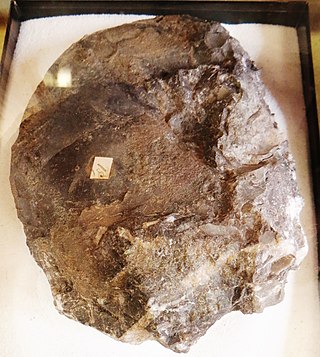
The Oncocerida comprise a diverse group of generally small nautiloid cephalopods known from the Middle Ordovician to the Mississippian, in which the connecting rings are thin and siphuncle segments are variably expanded. At present the order consists of some 16 families, a few of which, such as the Oncoceratidae, Brevicoceratidae, and Acleistoceratidae contain a fair number of genera each while others like the Trimeroceratidae and Archiacoceratidae are represented by only two or three.

The Acleistoceratidae is a family of oncocerids that contains genera characterized by depressed exogastric brevicones and cyrtocones that range from the Middle Silurian to the Middle Devonian. The siphuncle is broadly expanded, and in some actinosiphonate.
The Brevicoceratidae is a family of oncocerids that contains genera characterized by exogastric gyrocones, brevicones, and torticones. that tend to develop vestigial actinosiphonate deposits and subtriangular transverse sections. The Brevicoceratidae are derived from Oonoceras (Oncoceratidae) and range from the mid-Silurian to the Upper Devonian.
Jovellania is a genus of extinct prehistoric nautiloids from the order Oncocerida known from the Lower Devonian of Europe. Nautiloids form a broad group of shelled cephalopods that were once diverse and numerous but are now represented by only a handful of species in two genera.
Brevicoceras is an extinct nautiloid genus from the order Oncocerida with wide distribution in the Middle Devonian in Eastern North America, Russia and Morocco. Nautiloids form a broad group of shelled cephalopods that were once diverse and numerous but are now represented by only a handful of species in two genera.
Acleistoceras is a genus of the oncocerid, nautiloid family Acleistoceratidae that lived in the shallow seas that covered much of North America during the Devonian; living from 409—383.7 mya, existing for approximately 25.3 million years.
Basslerocerida is an order of nautiloid cephalopods from the Ordovician comprising exogastric longiconic cyrtocones, that is no longer in common use.
Jovellaniidae was established as a family within the Oncocerida to include genera characterized by longiconic orthocones and cyrtocones with a subtriangular to depressed cross-section in which the ventral (siphuncular) side is typically angular or more acutely rounded than the dorsal (antisiphuncular) side, and in which the siphuncle is generally large, ventral, and with lamellar actinosiphonate deposits
The Graciloceratidae is a family of nautiloid cephalopods from the Middle and Upper Ordovician belonging to the Oncocerida, characterized by exogastric cyrtocones that expand slightly or moderately and have thin walled, orthochoanitic marginal or subventral, tubular siphuncles.

Oncoceratidae is a family of nauatiloid cephalopods in the order Oncocerida established by Hyatt, 1884, that range from the Middle Ordovician to the Upper Silurian.
The Bassleroceratidae is a family of gradually expanding, smooth ellesmerocerids with a slight to moderate exogastric curvature, subcircular to strongly compressed cross section, and ventral orthochaonitc siphuncle. The ventral side is typically more sharply rounded than the dorsal side and septa are close spaced. Connecting rings are thick and slightly expanded into the siphuncle, making the segments slightly concave; characteristic of the Ellesmerocerida.
Hemiphragmoceratidae is a family of endogastrically brevconic oncocerids characterized by elaborately visored apertures in which the hyponomic sinus in mature specimens is on a spout-like process and there may be lateral and dorsal salients.. Shells are compressed with the apical portion curved and the anterior straight. Siphucles are nummuloideal with expanded spheroidal segments and continuously actinosiphonate interiors.
The Tripteroceratidae is a family of depressed, straight to slightly curved nautiloid cephalopods from the middle and upper Ordovician with generally flattened venters and empty siphuncles with straight to inflated segments included in the Oncocerida.

The Barrandeoceratidae is a family of coiled nautiloids included in the Tarphycerida that lived from the Middle Ordovician to the Middle Devonian, characterised by mostly compressed shells with a subcentral siphuncle composed of thin-walled segments that may become secondarily ventral.(Flower and Kummel 1950, Sweet 1964).
Minganoceras is a genus in the oncocerid family, Valcouroceratidae, named by Foeste, 1938, from the Middle Ordovician of Quebec, found on Mingan Island.
Actinomorpha is a genus of valcouroceratid, order Oncocerida, from the Middle Ordovician of central North America, named by Rousseau Flower, 1943. The shell is breviconic, short and laterally compressed; the venter more narrowly rounded than the dorsum, having the effect of a modest keel in horizontal orientation. The shell is gibbous adorally, such that the body chamber is widest well behind the aperture. The siphuncle is ventral, which could also be indicative of a horizontal orientation in life, with broad, slightly inflated segments and continuous, radial, actinosiphonate, deposits.
Augustoceras is a genus of nautiloid cephalopods included in the order Oncocerida and family Valcouroceratidae. It is known form the Middle and Upper Ordovician of Kentucky and Ohio in the US.
Valcouroceras is the type genus for the Valcouroceratidae, a family in the nautiloid order Oncocerida named by Rousseau Flower, 1943, named for Valcour Island in Lake Champlain, between New York state and Vermont, where it was first discovered.
The Barrandeocerina comprise a suborder of Early Paleozoic nautiloid cephalopods, primitively coiled but later forms may be cyrtoconic, gyroconic, torticonic, and even breviconic, all having empty siphuncles with thin connecting rings. The Barrandeocerina were originally defined as a separate order by Rousseau Flower, but since then have been united within the Tarphycerida as a suborder. Derivation is from the Tarphyceratidae.

The Nephriticeratidae is a family of early Paleozoic nautilod cephalopods included in the Barrandeocerina, distinguished by mostly cyrtoconic as well as gyroconic, sepenticontic, and sinstrally torticonic shells with large, typically straight necked (orthchoanitic) siphuncles. As for the suborder, connecting rings are thin.




